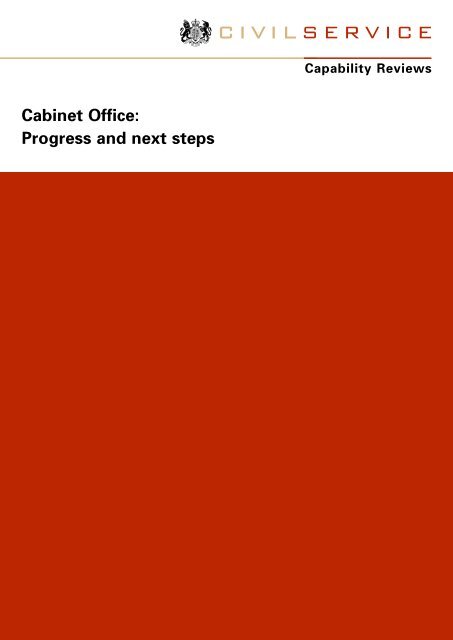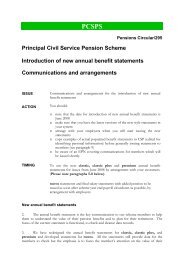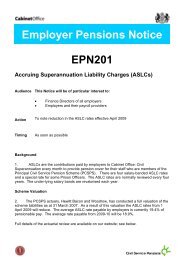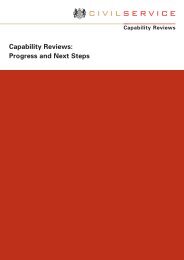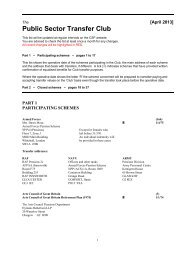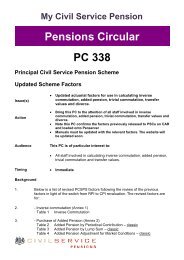Capability Review, December 2008 - The Civil Service
Capability Review, December 2008 - The Civil Service
Capability Review, December 2008 - The Civil Service
Create successful ePaper yourself
Turn your PDF publications into a flip-book with our unique Google optimized e-Paper software.
1. <strong>The</strong> Department<strong>The</strong> Cabinet Office’s aim – making government work better – is wideranging. <strong>The</strong> Department’s three core functions are to:• support the Prime Minister – to define and deliver the Government’sobjectives;• support the Cabinet – to drive the coherence, quality and delivery ofpolicy and operations across departments; and• strengthen the <strong>Civil</strong> <strong>Service</strong> – to ensure that it is organised effectivelyand has the capability in terms of skills, values and leadership to deliverthe Government’s objectives.<strong>The</strong>se functions are central to the Government’s ability to deliver itsobjectives and Public <strong>Service</strong> Agreements (PSAs): the Cabinet Office leadson one PSA and is a delivery partner for a further three. It also has to meetthe <strong>Service</strong> Transformation Agreement.<strong>The</strong> Cabinet Office published its three-year strategy for <strong>2008</strong>–11 in theComprehensive Spending <strong>Review</strong> White Paper in October 2007. To achieve itspurpose the Cabinet Office has six Departmental Strategic Objectives:1. Build an effective UK intelligence community in support of UK national interests;and the capabilities to deal with disruptive challenges to the UK.2. Support the Prime Minister and the Cabinet in domestic, European, overseasand defence policy making.3. a. Improve outcomes for the most excluded people in society.b. Enable a thriving third sector.4. Transform public services so that they better meet the individual needs of thecitizen and business.5. Build the capacity and capability of the <strong>Civil</strong> <strong>Service</strong> to deliver the Government’sobjectives.6. Promote the highest standards of propriety, integrity and governance inpublic life.<strong>The</strong> Cabinet Office budget is £342m this year. <strong>The</strong> Department employs 1,275 staff.<strong>The</strong> Cabinet Office leads on PSA 16:• Increase the proportion of socially excluded adults in settled accommodation andemployment.4 THE Department
It is also a delivery partner on a further three PSAs:• Build more cohesive, empowered and active communities (led by Communitiesand Local Government).• Reduce the risk to the UK and its interests overseas from international terrorism(led by the Home Office).• Reduce the impact of conflict through enhanced UK and international efforts (ledby the Foreign and Commonwealth Office).<strong>The</strong> Department also leads on delivery of the <strong>Service</strong> Transformation Agreement,the aim of which is:• To change public services so they more often meet the needs of people andbusinesses, rather than the needs of government, and by so doing reduce thefrustration and stress of accessing them.Cabinet Office: Progress and next steps5
<strong>The</strong>re has been a noticeable improvement in relationships andcoordination of activity at the centre of government and a highstandard of evidence-based work is being achieved in support of thePrime Minister, Cabinet and Government.• Relationships with the centre of Government have improved and, two years on,there is a greater commitment to closer working across Number 10, HM Treasury,the secretariats and other central government departments.• Collaborative working across the <strong>Civil</strong> <strong>Service</strong> has resulted in the delivery of keypieces of strategic work (for example, Security in a Global Hub, published inNovember 2007, Crime and Communities <strong>Review</strong>, published in June <strong>2008</strong> andFood Matters, published in July <strong>2008</strong>). Stakeholder feedback illustrates a greatersense of willingness to work together across the <strong>Civil</strong> <strong>Service</strong>.• <strong>The</strong> Department’s role as a neutral arbitrator and in bringing together relevantparties to resolve cross-cutting issues, for example in security and intelligenceareas, receives praise from staff, <strong>Civil</strong> <strong>Service</strong> leaders and stakeholders alike.<strong>The</strong>re is widespread recognition of the high quality of its work in supporting thePrime Minister, Cabinet and Government and in areas such as policy advice,strategy and crisis management.• Within the Cabinet Office, there is a strong culture of an evidence-basedapproach to policies and advice. Activity in areas such as the Strategy Unit,<strong>Capability</strong> <strong>Review</strong>s Team and the Office of the Third Sector relies on researchand intelligent analysis. Support has been introduced with the establishment ofthe Cabinet Office Analysis and Insight Team, and with investment in independentresearch on third sector issues.<strong>The</strong> Department needs to place greater emphasis on outcomes ratherthan processes, and to prioritise its objectives in order to increase thepace of delivery.• <strong>The</strong> 2007 staff survey revealed that 78 per cent of Cabinet Office staff understoodhow their work contributed to departmental objectives. However, fewer staff(37 per cent) felt that there was a well-formulated strategy. Many staff believe thata single unifying strategy for the Department will bring together its corporate anddelivery objectives and contribute to a sense of real purpose and understanding ofthe Cabinet Office’s value to the wider <strong>Civil</strong> <strong>Service</strong> and citizens.• Stakeholders (including those across the HR and Change communities) and staffat all levels believe fewer and more focused objectives would help to increase thepace of delivery across the Cabinet Office and the wider change agenda. <strong>The</strong>Department needs to prioritise its objectives, which with resource alignment willprovide greater focus on outcomes. This will bring increased confidence inachievability.Cabinet Office: Progress and next steps9
• People welcome the creation of matrix teams and joint initiatives with HMTreasury (for example the Compact, joint HM Treasury and Cabinet Office Boardmeetings and proposals for a <strong>Civil</strong> <strong>Service</strong> performance management framework)as a good start in developing common purpose. However, the benefits that resultfrom these initiatives could be made clearer. <strong>The</strong> Department now needs to focuson outcome delivery and ensuring that it realises the benefits of these initiatives.Delivery<strong>The</strong> Cabinet Office has made some progress in its high-level business andfinancial planning, and has put in place a new corporate governancestructure and a performance review process. <strong>The</strong> Department needs toimprove significantly those systems and processes where weaknessesremain. It must give urgent attention to models for delivery in some areasin order to provide clarity of accountability across the Cabinet Office andthe wider <strong>Civil</strong> <strong>Service</strong>.<strong>The</strong> Cabinet Office has made some progress in its high-level businessand financial planning, and has put in place a new corporate governancestructure and a performance review process.• <strong>The</strong> development of a departmental business plan with links to PSAs, its <strong>Service</strong>Transformation Agreement and to Departmental Strategic Objectives illustratessome improvement in areas of overall planning. Staff have welcomed itsdistillation into a one-page document.• <strong>The</strong>re is evidence of better high-level financial management compared with twoyears ago, and arrangements have been introduced to allow flexibility in theallocation of resources to meet new priorities.• A new corporate governance structure provides the opportunity for the Board toact more strategically, with operational business decisions being dealt with by aset of supporting sub-committees.• <strong>The</strong> Board has recognised the need to improve performance and deliverymanagement within the Cabinet Office and has introduced six-monthlyperformance reviews and an ‘Improving Delivery’ initiative.10 REVIEW FINDINGS
management through their teams and across the Department. <strong>The</strong>y will hold oneanother to account. Regular reviews and our reward strategy will ensure that everyoneis focused on delivery.We have reviewed our core management systems and organisation and havepartnered with the Department for Work and Pensions in order to share their financialand HR systems from April 2009. Amongst the benefits will be more clear and timelyfinancial and workforce information.We will continue to develop our new governance structures, ensuring that operationaland strategic decisions are taken at the appropriate level.To improve engagement with stakeholders we will, by January 2009, have a newcommunications strategy, which will strengthen staff and stakeholder understanding ofthe Cabinet Office’s role and objectives, and make us a more accessible organisation.Improving central coordination across governmentWhere there is a potential to increase our impact, we will continue to work hard to joinup our work at the centre of government, building on the progress recognised in thisreview.We have developed a new national security strategy. <strong>The</strong> strategy brings together theobjectives and plans for a wide range of Cabinet Office groups involved in security.We are working closely with HM Treasury in order to ensure that our performancemanagement requirements of government departments are coherent and manageablefor them, whilst providing robust and efficient assurance. We will continue to developour matrix teams, ensuring that we coordinate effectively with other departments.We have brought together, and provided greater focus to a range of public servicereform programmes through the publication, in June <strong>2008</strong>, of our strategy documentExcellence and Fairness: Achieving world class public services. <strong>The</strong> strategy providesa coherent framework for the objectives of the Office of the Third Sector, the SocialExclusion Task Force, Transformational Government, Workforce Reform, the domesticpolicy work of the Strategy Unit and HM Treasury.Transforming government servicesWe have focused our Transformational Government agenda to cover three priorityareas: ICT professionalism and technology, Shared <strong>Service</strong>s and Citizen-Centricservices.• <strong>The</strong> work on ICT is governed through the Chief Information Officer Council andwill be refreshed to incorporate the requirements of the Operational EfficiencyProgramme.Cabinet Office: Progress and next steps13
• <strong>The</strong> Shared <strong>Service</strong> programme will take forward benchmarking services acrossdepartments.• <strong>The</strong> Citizen-Centric work will support departments by addressing cross-cuttingthemes such as: setting strategy through customer insight; removing obstacles totransformation; and improving service delivery channels.• <strong>The</strong> Delivery Council will review its work in the light of the publication ofExcellence and Fairness, and this will be presented to permanent secretaries inthe first quarter of 2009.Strengthening the <strong>Civil</strong> <strong>Service</strong>We recognise that we need to increase the pace of change. We must seize theopportunity to capitalise on the ambition and momentum that we have created.We also agree with the review that every organisation needs to be clear about thedemands it will face in the future, and what those demands will mean. In the autumn,permanent secretaries, directors general and future leaders worked together todevelop the shared vision of the future challenges and priorities for the <strong>Civil</strong> <strong>Service</strong>.We will use the principles that this work identified to ensure that future activityacross the <strong>Civil</strong> <strong>Service</strong> is consistent and aligned. We know that the <strong>Civil</strong> <strong>Service</strong>has to become more flexible and adaptable to meet future challenges (whatever theymay be), but that it must also remain grounded in its enduring values of ‘objectivity,integrity, impartiality and honesty’.Focusing on the HR agenda, the <strong>Civil</strong> <strong>Service</strong> People Framework agreed by PSMGin July 2007 identifies the key areas (leadership, workforce, competencies and skills,employee engagement and well-being, and performance management) for collectiveaction. It has provided the basis for work in the past year, for example, on theintroduction of a common retirement age below the Senior <strong>Civil</strong> <strong>Service</strong> level. It willcontinue to guide <strong>Civil</strong> <strong>Service</strong> HR action in the coming period. <strong>The</strong> introduction of acommon ‘people survey’ across departments next year will enable us to measureprogress consistently.ConclusionMuch of this work has already started. We will develop a more detailed action plan inorder to respond to the challenges of the <strong>Capability</strong> <strong>Review</strong>. <strong>The</strong> plan will ensurethat our leaders lead by example and that all staff are involved in creating positiveorganisational change.Cabinet Office<strong>December</strong> <strong>2008</strong>14 departmentAL RESPONSE: PLANS FOR CONTINUOUS IMPROVEMENT
Annex A: <strong>The</strong> model of capabilityDeliveryManageperformanceSet directionDevelop clearroles, responsibilitiesand deliverymodel(s)D3L1Ignite passion,pace and driveLeadershipD2L2Plan,resource andprioritiseD1L3Take responsibilityfor leading deliveryand changeS3L4BuildcommonpurposeS2S1BuildcapabilityBase choiceson evidenceFocus onoutcomesStrategy<strong>The</strong> model of capability has been designed specifically for the <strong>Capability</strong> <strong>Review</strong>s.It was developed through consultation with senior leaders in Whitehall and externalexperts. <strong>The</strong> model is deliberately selective and designed to focus on the mostcrucial areas of capability – leadership, strategy and delivery.<strong>The</strong> scope of the reviews is to assess the capability of departments’ seniorleadership in the areas above, using the model of capability. <strong>The</strong> model enablesjudgements to be made against 10 elements across leadership, strategy anddelivery, using an underlying group of 39 questions. For further information on themodel of capability see www.civilservice.gov.uk/capabilityreviews.Each review has been carried out by the <strong>Capability</strong> <strong>Review</strong>s Team with a team ofexternal reviewers assembled specially for the department under review. <strong>The</strong>sereviewers have been drawn from the private sector, the wider public sector andboards of other government departments.<strong>The</strong> <strong>Capability</strong> <strong>Review</strong>s Team will regularly review progress and provide support tohelp ensure that the department is on track to deliver.Cabinet Office: Progress and next steps15
Annex B: Assessment categoriesStrong – good capability for future delivery in place, in line with thecapability model. Clear focus on the action and improvement requiredto deliver transformation over the medium term.Well placed – well placed to address any gaps in capability for futuredelivery through practical actions that are planned or already underway.Is making improvements in capability and is expected to improve furtherin the medium term.Development area – the department should be capable of addressingsome significant weaknesses in capability for future delivery by takingremedial action. More action is required to close those gaps and deliverimprovement over the medium term.Urgent development area – significant weaknesses in capability for futuredelivery that require urgent action. Not well placed to address weaknessesand needs significant additional action and support to secure effectivedelivery. Not well placed to deliver improvement over the medium term.Serious concerns – serious concerns about current capability.Intervention is required to address current weaknesses and secureimprovement in the medium term. (NB only used infrequently, for themost serious gaps.)16 Annex B: Assessment categories
<strong>Capability</strong> <strong>Review</strong>s TeamCabinet OfficeAdmiralty Arch<strong>The</strong> MallLondon SW1A 2WHTelephone: 020 7276 1369E-mail: capabilityreviews@cabinet-office.x.gsi.gov.ukWeb address: www.civilservice.gov.uk/capabilityreviewsPublication date: <strong>December</strong> <strong>2008</strong>© Crown copyright <strong>2008</strong>All rights reserved by the Cabinet Office, United Kingdom. No part of thispublication may be copied or reproduced or stored or transmitted in anyform without the prior written consent of the Cabinet Office.For permission please contact capabilityreviews@cabinet-office.x.gsi.gov.uk<strong>The</strong> material used in this publication is constituted from 75% post-consumer waste and 25% virgin fibreRef: 290854/1208Prepared for the Cabinet Office by COI


